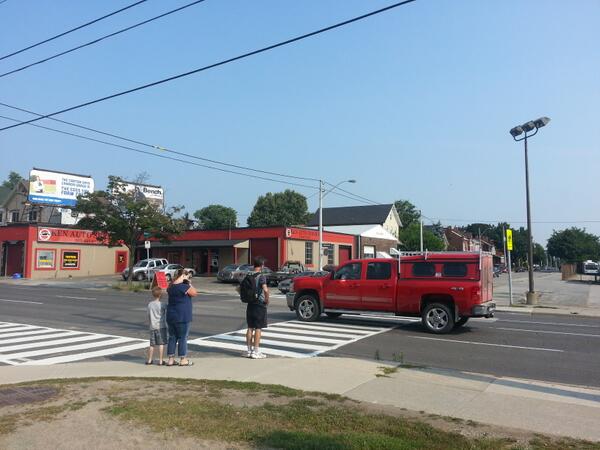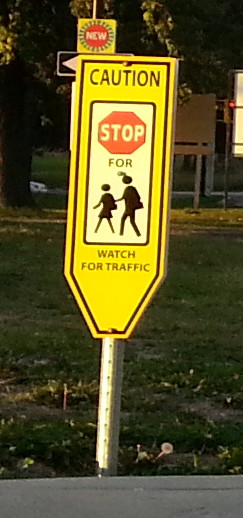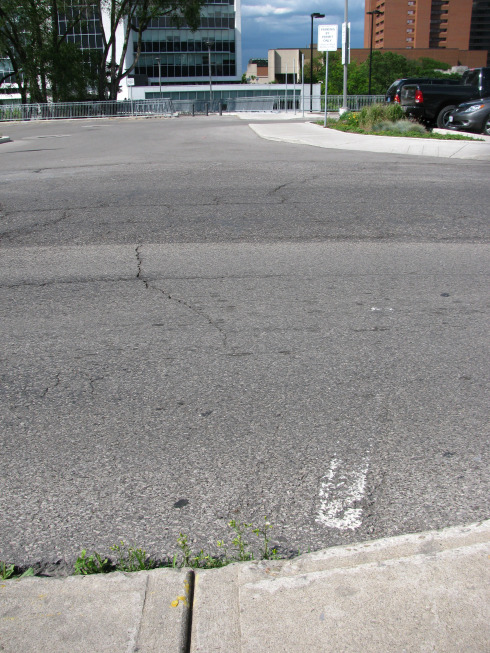The City should be trying to educate drivers that they do have to yield to pedestrians crossing legally at an uncontrolled intersection.
By Ryan McGreal
Published November 08, 2013
Last week, the City released a new proposal for a Pedestrian Signal Program [PDF] that includes a "Courtesy Crossing" pilot project to provide more visible crosswalks at uncontrolled intersections. Incredibly, the proposal suggested putting up signs for pedestrians that read, "Caution - Vehicles Not Required to Stop".

Uncontrolled intersection on Cannon at Elgin (RTH file photo)
However, this wording has not yet been finalized. According to Kelly Anderson, spokesperson for the Public Works Department, "There will be a significant amount of planning before anything is implemented. No specific wording has been finalized at this point."
The proposed signage wording comes from a recommendation by the city's Legal and Risk Management staff, "based on their interpretation" of the Highway Traffic Act.
I struggle to understand what interpretation of the Highway Traffic Act could have led to a sign telling pedestrians that motorists are not required to stop for them. As the Act specifies and an Ontario Transportation Ministry (MTO) spokesperson recently clarified for RTH, motorists absolutely do have to yield to a pedestrian who has started crossing an uncontrolled intersection. Likewise, pedestrians have to wait for a gap that is large enough that motorists have time to stop.
Anderson notes that City staff will consult further with Legal and the MTO before finalizing and implementing the project. She adds that the project "will involve a comprehensive education strategy."
It's good to hear that the wording has not yet been finalized, because the current proposed wording is misleading and dangerous.
The city should be trying to educate drivers that they do have to yield to pedestrians crossing in an uncontrolled intersection. As a model, the City should consider the signs in place at the McMaster and Mohawk campuses, which are directed at motorists, not pedestrians:

'Stop for pedestrians' sign at Mohawk College Fennell Campus (RTH file photo)
For a long time, the city's Legal department has been myopically risk-averse and liability-oriented. I've been given to understand their interpretation of the HTA led the traffic department under Hart Solomon to abandon maintenance on uncontrolled intersections altogether as a way of reducing the City's potential liability in the case of a pedestrian collision.
This produced the confusing phenomenon of 'ghost crosswalks' in which it is not clear whether pedestrians are even allowed to cross, effectively denying pedestrians the right to cross the street.

Ghost crosswalk on Hunter near City Hall (Image Credit: Undustrial)
As a recent SPRC report indicates, the legacy of Hamilton's approach to pedestrian safety has been a dismal, shameful pedestrian safety record. In other words, the City's efforts to reduce its liability risk have actually increased the risk of injury to pedestrians!
I strongly encourage City staff to recommend signage that focuses on reminding drivers about their legal responsibilities, rather than scaring off pedestrians to avoid liability.
I shudder to think of the legal ramifications for the City if a motorist runs over a pedestrian after wrongly concluding from an official sign that they don't have to stop.
By jason (registered) | Posted November 08, 2013 at 09:46:59
I thought for sure that the city would recommend the yellow, mid street signs like Mac has everywhere. I've been in many cities with them and they work great. Very clearly marked that cars must stop when pedestrians are around.
By eastofjames (registered) - website | Posted November 10, 2013 at 05:28:37 in reply to Comment 94531
Perhaps the future of pedestrian safety can be found in the past...complete two way streets with marked pedestrian crossings at reasonable distances from each other, this would cut back on jay walking and improve safety for all involved.
By seancb (registered) - website | Posted November 08, 2013 at 10:24:18 in reply to Comment 94531
I'd be fine with "wait for gap" signs if they were accompanied with signs telling motorists to yield to crossing pedestrians.
All these signs just seem so wasteful though. The city is obsessed with signing every minor road change. A residential street goes 2-way and there has to be a sign every 100 meters reminding people how to drive on a 2 way street? it's not necessary.
Why can't we just adopt a standard paint colour/pattern and get down to business painting every crossing starting with the most dangerous ones. We can put signs on a few of the big ones, and let the information filter in that the same rules apply to every crosswalk. I'm pretty sure people will figure it out.
At the risk of attracting trolls who will rant about anecdotes of unsafe pedestrian activity, I will state that pedestrians inherently understand they have to wait for a gap in traffic before crossing, since they have a fundamental instinct for self preservation. Signs are redundant. The few pedestrians who don't care about their own safety aren't going to change their habits due to a sign. If we are going to remind anyone about the laws, we should be reminding drivers, who are capable of inflicting much greater damage on others than a pedestrian can.
By movedtohamilton (registered) | Posted November 08, 2013 at 09:53:57
I'm surprised that the Legal department thinks the City's liability would vanish like the paint on the crosswalk. Would the ghost come back to haunt it during a lawsuit? But I'm no lawyer so I would love to see a legal viewpoint from a lawyer reading this.
By j.servus (registered) | Posted November 08, 2013 at 09:57:38
Any pedestrian who is paying attention will spontaneously wait for a gap large enough for oncoming traffic to stop. No one needs a sign for that.
By lemalas (registered) | Posted November 08, 2013 at 10:10:28 in reply to Comment 94534
By that same logic, we should get rid of stop signs.
By mikeyj (registered) | Posted November 08, 2013 at 11:33:05 in reply to Comment 94536
Not completely, but you could easily eliminate stop signs from non-arterial roads with benefits instead of what you likely perceive as absolute chaos.
All unsigned/uncontrolled intersections would simply be treated as 3 or 4 way yields, as already in the Traffic Act.
You'd likely see higher driver alertness at all intersections, and generally slower speeds in residential neighborhoods as drivers blowing through intersections gaining more speed would be reduced greatly. Additionally you'd eliminate a pretty significant cost to municipalities in buying, installing and maintaining unnecessary signs for every intersection.
Comment edited by administrator Ryan on 2013-11-08 12:16:00
By kevlahan (registered) | Posted November 08, 2013 at 11:41:00 in reply to Comment 94542
That an excellent point: much of the signage and traffic control systems is NOT aimed at increasing safety, but allowing higher traffic flow with reasonable safety.
The so-called woonerf streets are an extreme example: no signs, no pavement markings, no distinction between road and sidewalk. They are safe, because they require everyone to take responsibility for their own safety because they can't point to "right of ways". But the speeds are very slow.
http://en.wikipedia.org/wiki/Woonerf
In a way, Hamilton has its own woonerf on George St in Hess Village between Queen and Hess. The street is open to vehicles, as well as pedestrians, with no controls at all times of day so it is not a true pedestrian street.
By seancb (registered) - website | Posted November 08, 2013 at 10:18:11 in reply to Comment 94536
That is nowhere near the same logic.
By lemalas (registered) | Posted November 08, 2013 at 11:05:20 in reply to Comment 94537
Really, you don't see it? I hadn't had my coffee yet when I wrote that, but I stand by it. Behold: "Any driver who is paying attention will spontaneously wait for a gap large enough for oncoming traffic to stop. No one needs a sign for that."
By j.servus (registered) | Posted November 09, 2013 at 11:04:54 in reply to Comment 94540
There is a vast difference in the way pedestrians are conditioned to operate, and the way motorists are conditioned to operate. As others have observed, pedestrians already treat every crossing as a yield situation for them. They won't cross until they're reasonably sure it's safe to do so, and the spontaneous threshold of safety is a judgement that oncoming traffic has at least enough time to notice and react appropriately. Moreover, pedestrians treat every point of crossing as an intersection.
Motorists, on the other hand, do not spontaneously perceive all intersections as a yield situation for them. Rights of way for auto traffic are variable, and drivers both expect and need instructions to know what to do. They will default to yield only if it is indicated, or if the situation is radically unclear (e.g., if the traffic signals go out). Moreover, motorists are conditioned to perceive intersections only where another street crosses. They do not readily perceive pedestrian points of crossing as intersections, unless some other affirmative indication is given, e.g., painted stripes and yellow lights.
By RobF (registered) | Posted November 08, 2013 at 11:43:08 in reply to Comment 94540
Different problem altogether.
By seancb (registered) - website | Posted November 08, 2013 at 11:13:26 in reply to Comment 94540
This actually does work: http://www.spiegel.de/international/spie...
But it certainly would disrupt the "free flow" that many drivers want, as you'd have to slow down and treat every single intersection as a yield.
By RobF (registered) | Posted November 08, 2013 at 11:52:09 in reply to Comment 94541
Interesting idea ... I see the logic, but it is likely that the uncertainty would favour aggressive drivers over more defensive or cautious ones just like the city's passive-aggressive interpretation of the Highway Act ensures that pedestrians who care about their safety don't assert their right-of-way as per the act. I'd welcome signs on James North at Colbourne and Robert that clearly inform drivers to stop or yield when pedestrians are crossing.
By Pxtl (registered) - website | Posted November 08, 2013 at 13:17:59
The city can thank Hart Solomon for this. If he hadn't created the "Ghost Crosswalks" problem, the public wouldn't have a confusion about the nature of crossings and the city could continue to paint crosswalks freely for unprotected crossings.
But now? Now some pedestrians are used to the idea that a crosswalk signals a somehow-protected crossing, and this represents a liability for the city. And there's no good way to explain to everybody "this is a crossing without a specific yield, everybody just needs to be courteous" without giving somebody the wrong impression.
If people were used to seeing crosswalks on uncontrolled intersections, this whole issue could've been avoided.
Thanks, Solomon.
By kevlahan (registered) | Posted November 08, 2013 at 15:05:07 in reply to Comment 94547
The MTO has explained clearly the rules for pedestrians and motorists at an uncontrolled intersection (technically referred to as a "crosswalk" in the Highway Traffic Act):
Pedestrians: must wait for a large enough gap so that motorists have time to come to a safe stop.
Motorists: must yield (slow down or stop) for crossing pedestrians. Motorists do not have to stop for pedestrians until they step off the curb (i.e. if they are just waiting to cross).
It really is pretty straightforward ... except that in Hamilton we seem to have forgotten about the motorists responsibility to yield to crossing pedestrians, we focus only on pedestrians "waiting for a gap" which has morphed into waiting for a gap so large that motorists don't need to even slow down!
Comment edited by kevlahan on 2013-11-08 15:06:05
By mikeonthemountain (registered) | Posted November 09, 2013 at 06:54:58 in reply to Comment 94553
The reports we were just given about Hamilton ped safety listed the fatalities over the years - did you notice most of them were elderly? A few months ago I was biking along Garth and witnessed an old man crossing slowly with a cane, far from a light (for him), almost get mowed down by a green wave. I watched the whole thing. There was sufficient gap for him to cross when he started, but he only made it across two of four lanes, when the northbound green wave caught up to him. Cars were veering into oncoming lanes to wrap around this man. He was crossing at an uncontrolled intersection.
Just as I was slowing to get off my bike and stop traffic myself and escort this man across the street, finally someone stopped, and then others did too. It seemed a textbook lack of education - as soon as the first car stopped, everyone else was happy to do so. But the first bunch of cars never thought to. People driving really don't know that they are to stop for someone who has started to cross. I understand the perspective - without the painted lines, sign, or widespread public education - the drivers feels afraid to stop in the middle of the road, get rear ended, and be at fault. Who stops their car randomly in the middle of a busy road? This is the missing education component. Those courtesy crossing signs will be invaluable as a part of an educational campaign. People simply don't know right now what to do.
How many elderly crossing the street, most of the fatalities on the list, didn't make it across the street in time despite their best effort? (oh great, now I wanna cry)
edit: I accidentally some words when I type fast.
Comment edited by mikeonthemountain on 2013-11-09 06:58:43
By Mxyzptlk (anonymous) | Posted November 08, 2013 at 13:35:01 in reply to Comment 94547
Solution: repaint the sidewalks and people will get used to seeing them again.
By Kevin Love (anonymous) | Posted November 08, 2013 at 16:05:32
There are few things in the world that cannot be fixed with a little bit of common sense and courtesy. When I come to an intersection, I do not expect car drivers to be mind readers and know that I want to cross. So I let them know and signal to them in the universal palm outward Halt signal. 90% of them respect this and come to a stop and I cross the street.
By Kevin Love (anonymous) | Posted November 08, 2013 at 16:06:15 in reply to Comment 94556
As for the other 10%, that's what law enforcement is for.
By movedtohamilton (registered) | Posted November 08, 2013 at 16:23:29
This morning on a street in my neighbourhood I yelled at a speeding driver to slow down. He sped up. Kevin, no law enforcement ever around for the other 10%.
By grahamm (registered) | Posted November 08, 2013 at 20:44:22
I watched two cars turn from Charlton to Queen tonight while a boy, who was maybe 13, waited to cross Westbound on the South side of Charlton with the light. The third car waited, but I couldn't believe my eyes. Since when was it ok to use the time that it takes a pedestrian to get halfway across the street as an opportunity to turn left?
Progress is being made for pedestrians, but there is a big culture shift that needs to happen within the ranks of drivers to re-prioritize pedestrians and give them right of way when it is rightfully theirs. This was succinctly summarized back in August in the article [Raise the Pedestrian] (http://www.raisethehammer.org/article/1934/raise_the_pedestrian "Raise The Pedestrian").
The signs Ryan is suggesting give the pedestrians the rights that are theirs by law and would do more to change the culture among drivers than what is proposed. The proposed signs remind me of the "Pedestrians To Cross on Other Side" signs.
Comment edited by grahamm on 2013-11-08 20:45:03
By J (registered) | Posted November 08, 2013 at 21:31:19
let me see if I get this straight: you read the highway traffic act and talked to a guy at MTO and now you've convinced yourself that you know better than the City's legal department? Got it. Good luck with your future endeavours.
By matlock_expressway (registered) | Posted November 09, 2013 at 17:04:33 in reply to Comment 94569
I think the point was that if the city's legal department says that drivers have no obligation to stop unless they can stop safely, then signs that note only the first part of that claim ("drivers have no obligation to stop"), without mentioning the exception to that rule that applies in the vast majority of cases, are stating something false... and probably encouraging drivers to break the law.
Comment edited by matlock_expressway on 2013-11-09 17:06:10
By seancb (registered) - website | Posted November 08, 2013 at 22:22:41
Because the city's legal department has an impeccable track record. Got it.
By SpaceMonkey (registered) | Posted November 10, 2013 at 11:39:20
Uncontrolled intersection cross walks on a main road look, to me, like an accident waiting to happen.
To me, that seems more dangerous than having no cross walk at all. If the pedestrians are EXPECTING a car to stop, it could be really dangerous. I'm not absolving the driver of responsibility. If the person driving the car hit the person walking, the person driving would be at fault.
On major roads, it would see safer, to me, to have controlled cross walks where there needs to be a cross walk or no cross walk.
Comment edited by SpaceMonkey on 2013-11-10 11:40:15
You must be logged in to comment.
There are no upcoming events right now.
Why not post one?